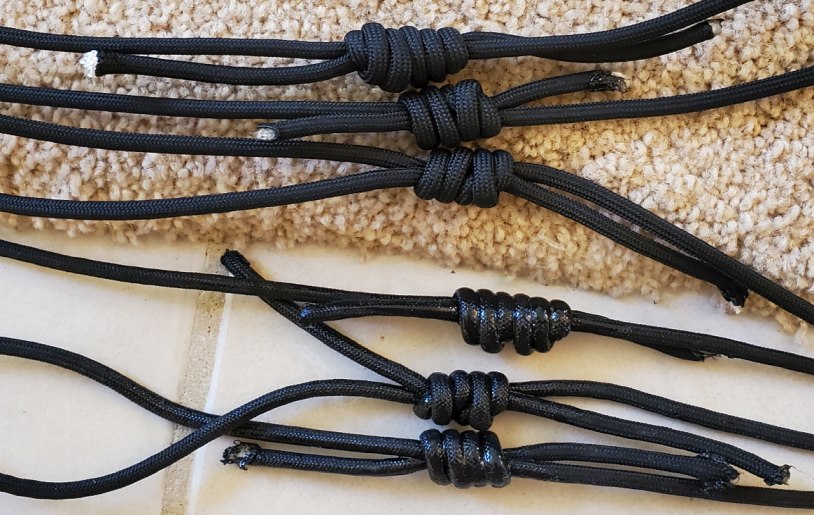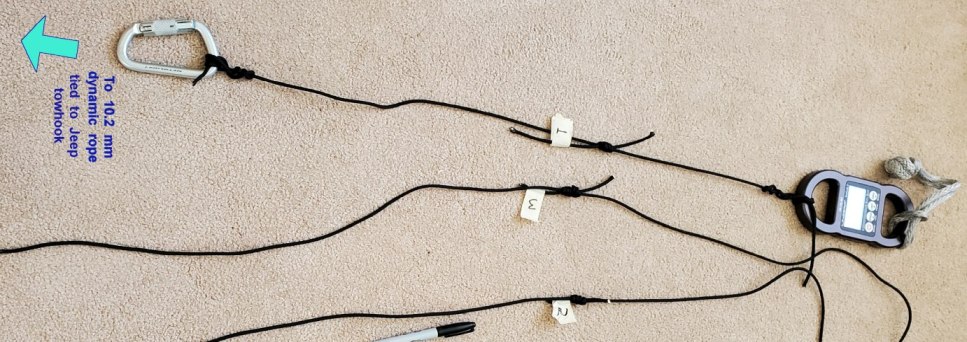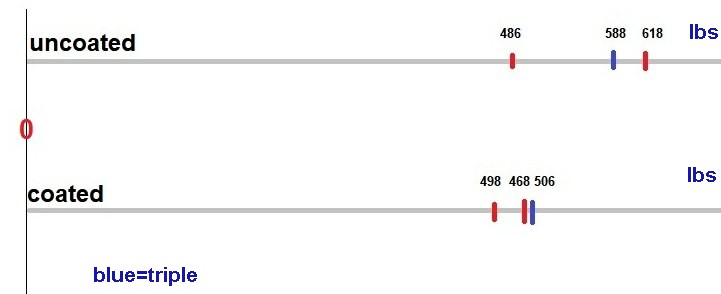
Do urethane coatings weaken knots? See update at end of page.
Many manufacturers offer water-soluble urethane
coatings
(e.g. Yale Maxi Jacket) that add abrasion and UV resistance to ropes. I
have
used Seam Grip urethane (toluene carrier) to coat the outside of knots
or exposed
stitching, and to coat eyesplices. But coatings, if thick enough, add
friction, and can add a lot of energy to the rope surfaces when they
are pulled against each other. This extra energy may be manifest as a
rapid local heating, and cause the rope to fail (see UIAA tests pdf on
this site for an explanation). If so, how
much? I had just seen a urethane-saturated triple fisherman's fail in
the knot at a lower-than-expected force, so I was interested in testing
this hypothesis.
I took the “750 lb” paracord used in the butterfly
knot
tests, and tied two pieces together with double or triple fisherman’s
knots in
6 samples. The paracord has 55% of its mass in the core, and has an
actual
breaking strength over 800 lbs. On three of the samples, I massaged
Seam Grip
into the knots and let it cure overnight. One end of each cord was tied
directly to the linescale 3 load cell with a modified trilene knot. The
other
end was tied to a carabiner with a trilene knot (figures below;
modified trilene
knots preserve at least 90% of the rope native strength, because there
are no
tight bends in the load strand). The carabiner was clipped to a
figure-8-on-a-bight in an 8’ length of 10.2 mm dynamic rope. The
dynamic rope
was attached to the towhook of my jeep. I pulled each of 6 knots to
breaking with my Jeep, in sequence, retying new trilene knots
each time.


The results were scattered, but overall, the knots
saturated
with urethane broke at 87 +/- 13% of full strength, an ambiguous
result. A fuller test would use more
samples, but this gives a slight indication that the urethane coating
may
weaken knots, and gives advice not to saturate the insides of the
knots. The urethane saturation in this test was pretty extreme, and the
change not that great; so one must balance the risk from UV and
abrasion against a possible small strength loss.

I later tested liberal coatings of MaxiJacket, versus Aquaseal/SeamGrip (McNett) urethane on 4000 lb bs Amsteel.
The SeamGrip-coated sample broke at 2800 lbs, whereas the MaxiJacket
broke at 3900 lbs. The SeamGrip is quite tough and gets in among the
fibers, and very much affects how the fibers interact with each other
-- essentially there is a lot more fiber-fiber friction. The Maxijacket
abrades a lot more easily, and doesn't seem anywhere as tough as the
McNett urethanes -- and here, for a UV-coating, that is a good thing.
I've stopped using the McNett urethanes with Dyneema, except very
external applications where is just keeps sewing from abrading, or just
saturates an outside sheath added for stiffness (as a footloop, e.g.).